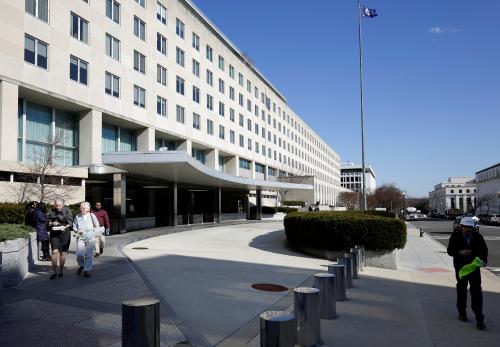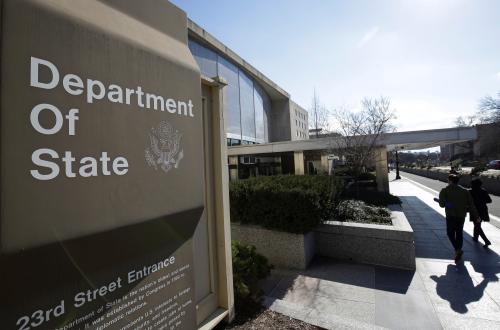This piece is part of a series remembering the life, career, and legacy of Helmut (Hal) Sonnenfeldt — a member of the National Security Council, counselor at the Department of State, scholar at the Johns Hopkins School of Advanced International Studies (SAIS), and Brookings expert.
Sixty years ago this September as a first-year student at the Johns Hopkins School of Advanced International Studies (SAIS), I joined Hal Sonnenfeldt’s course on Soviet foreign policy. We scoured the Foreign Broadcast Information Service reports trying to make sense of the sterile, convoluted language of Soviet-speak. Hal’s writing assignments could have been comfortably handled in eight pages, but he accepted only two. Many years later, in my own teaching, I adopted Hal’s two-page paper drill; if looks could kill I would have been dead at the moment my students turned in their first papers. A painful assignment for sure. I’m not sure it occurred to us at the time that a fundamental underlying method in Hal’s approach was that to understand the Soviets, we had to listen to what they were saying and what they were not saying. Words counted heavily — theirs and, in our two-page papers, ours.
This was slightly less than two years after Sputnik and about a week since Nikita Khrushchev had concluded his spectacular visit to the United States and his Camp David meeting with President Dwight Eisenhower. The Soviet downing of an American U-2 spy plane and the exploded Paris four-power summit were several months away, construction of the Berlin Wall a little less than two years. Looking back, it was a perfect time to enter the world of Soviet foreign policy.
At that time, we and the Soviets were strongly committed to leadership of different international communities, including military alliances. Sino-Soviet differences were beginning to emerge, but in 1959, the Soviet Union appeared secure in its leadership, at least to most of us who were students. In this period of sharp zig-zags in our relations, we and the Soviets had not yet developed a systematic way of dealing with each other. That would come in the late 1960s and early ’70s, when Hal was a key member of Henry Kissinger’s National Security Council staff and when we opened negotiations with the Soviet Union on strategic nuclear arms, conventional forces in Europe, and principles of international relations in Europe. While the United States and the Soviet Union remained adversaries, we were able to establish structures that facilitated diplomacy on sensitive issues and that contributed to stability in our relations. That process, which yielded significant agreements, continued for over four decades, outlasting the existence of the Soviet Union itself.
And now, 60 years later? Would those of us in Hal’s 1959 class at SAIS find anything familiar? Well yes, a few things. For example, it’s hard not to notice a striking similarity in Russia’s strategy for annexing Crimea in 2014 with the Soviet approach to forcibly incorporating the Baltic Republics in 1940. (When you’ve got a playbook that works for you, why change it?) The cautious but forceful opportunism of Russia today would seem familiar. Distrust of the West? A visceral dislike of European integration? Antipathy towards NATO? Not so different today.
The arms control arena is a bit more complex. Perhaps someday China will join the trilateral arms talks that have been proposed, but at the moment it seems uninterested in doing so. There is a possibility that the U.S.-Russia arms control agreement New START will not be extended or succeeded soon by a different agreement. If New START lapses, we are in danger of losing not only the last remaining nuclear arms agreement with Russia, but possibly also lose the diplomatic framework for talks and negotiations. In some respects, this could transport us back to 1959, with each side free to pursue nuclear weapons without restraint and without a firm structure for addressing these issues.
What is truly different today is that the positions of the United States and Russia in the world have changed. Russia, considerably reduced in size and structure from the Soviet Union, is no longer the leader of an alliance or of a discernible international community. Whether the United States itself is committed to international leadership, generally, is now an open question. It appears that at this moment we have two heavily armed but somewhat unmoored powers facing each other squarely but not always certain how to define and carry out their relationship.
Sixty years ago we had a reasonably firm grasp of Soviet goals in the world. As Hal taught us to do, we listened carefully to what they said. Hal’s approach is now more important than ever, especially because Russia is necessarily going through a period of redefining itself. So, we must listen. Gone are the mind-numbing stock Marxist-Leninist phrases, replaced by more fluid language with overtones of imperial grandeur and not very well-defined “Eurasianism.” This, I think, makes Russia rather unpredictable. But, then, so are we.






Commentary
Reflections of a student of Helmut Sonnenfeldt
October 17, 2019